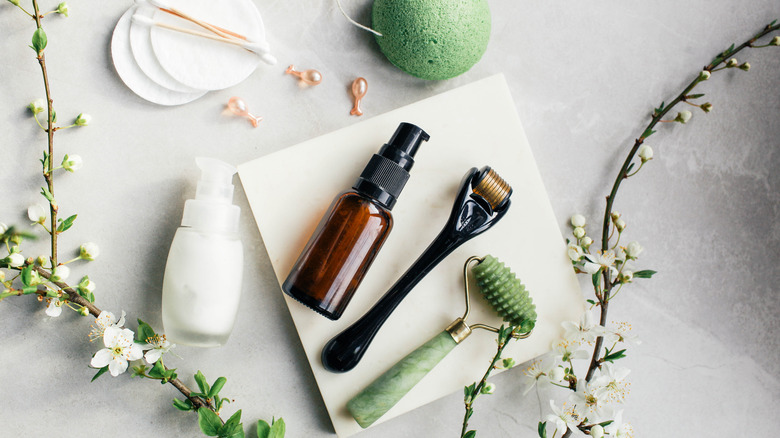Three Key Ingredients To Maximize Your Derma-Rolling Benefits
You've likely already heard of derma-rolling via TikTok, but if you haven't, it's basically the DIY version of microneedling. Using a handheld derma-roller, you rotate .25 – 1.5-millimeter needles across your face and neck. While this sounds like a form of torture rather than a skincare step, the pain is usually minimal, and according to many beauty experts, the benefits are worth it.
Board-certified dermatologist Dr. Michelle Henry explained to MindBodyGreen that the punctures caused by the derma-roller signal the skin to go into repair. In an effort to heal these micro-wounds, the body will boost its collagen production. According to Henry, this process can smooth out wrinkles and heal acne scars.
Derma-rolling alone can lead to firmer, brighter skin but it can also increase the benefits of other products in your skincare routine. "The dermaroller also creates microchannels that allow for increased product absorption into the skin, making products applied to the face more effective," certified trichologist Helen Reavey said.
You shouldn't combine derma-rolling with just any face product, though. There are three ingredients that will help you maximize the effects of derma-rolling and avoid infections.
These three ingredients will upgrade your derma-rolling routine
If you're already derma-rolling or considering starting, you're probably hoping to even out your skin texture and brighten its tone. If you want to increase your chance of seeing these results, consider pairing your derma-rolling with serum ingredients that promote skin cell renewal.
To maximize your skin moisture, you want to use hyaluronic acid. According to Medical News Today, hyaluronic acid attaches itself to water molecules. This chemical compound is stored naturally in our bodies to keep the skin hydrated. As we age, our supply of hyaluronic acid drops, causing our skin to become less firm. By placing hyaluronic acid on the skin and pressing it inwards with a derma-roller, you can replenish this recourse, making wrinkles and scars appear less defined.
While hyaluronic acid will provide your skin's moisture levels, ingredients like epidermal growth factors (EGFs) and peptides can help rebuild damaged skin cells. In an interview with Allure, dermatologist Estee Williams explained that EGFs signal our cells to begin rejuvenating when they come in contact with our skin. Similarly, peptides in skin cream can help your body produce collagen and elastin — two key factors of skin health (via WebMD.)
What to avoid when derma-rolling
While derma-rolling pairs perfectly with some ingredients, others can cause harm. Celebrity facialist Candace Marino told Marie Claire that hyaluronic acid, EGFs, and peptides are all substances that our bodies naturally produce. And because of this, they are safe to incorporate into your derma-rolling routine. However, Marino cautions, "Certain ingredients are not meant for the bloodstream, so do not grab for your vitamin C or glycolic acid and start going to town with your dermaroller." In addition, MindBodyGreen recommends that you steer clear of lactic acid, salicylic acid, and retinol to avoid irritation.
You should also avoid contact with the sun while derma-rolling. Healthline explains that your skin is more susceptible to damage after derma-rolling and should be shielded from UV light. Obviously, that doesn't mean you can't leave your house, but rather, pick a high-quality sunscreen and apply it daily.
Following these guidelines may help you achieve your skin goals. However, all skin is different. To be safe, we recommend you consult a medical professional before attempting any skin treatments.


